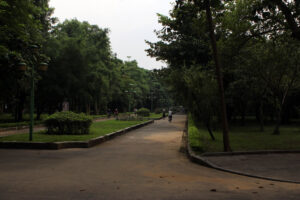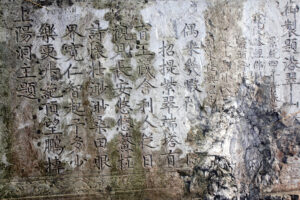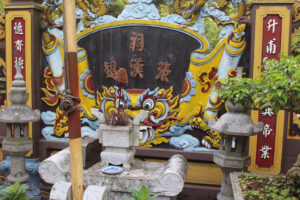Although the literal translation of Non Nước is “Water Mountain,” the true meaning of the term describes a place where a scenic mountain landscape is mirrored by an equally appealing water spot, such as a river or beach. Da Nang’s Non Nước Beach, which is regarded as one of the most stunning beaches globally, is an example of such a place. Additionally, the ancient Non Nước Pagoda near the Cau River in Hanoi has been renowned for centuries as a serene and scenic spiritual center.
Almost as ancient as that famous Pagoda in Thang Long and way before Da Nang was an important trade centre, there was the Non Nước Pagoda of Ninh Binh. Not far from the city center, the Pagoda lies at the foot of a large limestone outcrop at the conjunction of the iconic Day and Van Rivers.
For a millennia this tiny enclave of spiritualism, beauty and hope has weathered war, climate, neglect and vandalism. Continually rebuilt and expanded over countless generations, Non Nuoc has retained its beauty and respect as a revered place of contemplation, meditation and celebration.
The modern incarnation of Non Nước has joined with the Thuy Son Park recreational area – a 2km square, tree lined preserve that also includes a large walking area, the Ninh Binh Museum, Duc Thuy mountain, the Truong Han Sieu temple and the Non Nuoc pagoda itself.
While the reserve itself may not be as grandiose as some Vietnamese Public parks, the wide stone paths and park benches have created a very pleasant exercise and meeting place for many locals. The small forest of mature trees provides a much needed respite from the summer heat and winter winds and is part of the “green lungs” of Ninh Binh City.
A Place of Peace
The entrance to the pagoda itself can be difficult to find. You need to follow the road that runs at the top of the park until it makes a right hand turn into a cul de sac. The large gates are on your left, looking more like a tradesman entrance than the entry to one of the most beautiful temples in the city. Remember at all times that this is a living house of god. Dress appropriately, keep the noise down and succumb to the calming enchanment of one of Ninh Binh’s most sacred Pagodas.
Kept in pristine condition the courtyard is filled with statues depicting a pantheon of spiritual figures . From imagery of revered monks to the enormous depiction of the preeminent female Bodhisattva Guanyin there is also Hanuman and the “pig” deity Zhu Bajie and a full representation of the various figures in the zodiac. All intricately carved in smooth white marble, many are quite recent and display the skills and craftsmanship passed down through the ages and very much alive today.
The rock overhang at the rear of the altar house gives the mountain its name (Duc Thuy roughly translates as “drinking bird”). A sheer cliff overburdened with luxuriant foliage, during daylight hours the sun throws cool shadows across the river below, creating a scene straight out of a thousand Vietnamese water colours. On the riverside, hidden at the far back of the pagoda is a small cave with numerous statues to the Mother Goddess, the “old” religion of Dao Mau that celebrates women. This “old religion” gives considerable weight to the theory that pre-historical Vietnam was a matriarchal society, similar to ancient Cham (Cambodia) and some of the existing tribal groups within modern day Vietnam.
Historical Significance
This serene area of Ninh Binh city encapsulates much of known Vietnamese history. On one side of the mountain is the Truong Han Sieu Temple, tribute to the renowned Confucian poet and administrator of the Tran Dynasty. At the center and on top of the mountain itself are the remains of several reiterations of a watchtower built to guard Ninh Binh from riverine invaders. To the right hand side is Non Nước Pagoda itself, a holy place first constructed during the reign of King Ly Nhan Tong (1072 -1128) and dedicated to Buddhism. And within that is the ancient, perhaps original, altar to an even more ancient Mother Goddess.
It is said that the first Emperor Dowager of Dai Viet (Vietnam), Duong Van Nga, waited here for the Emperor Li Hoan’s return from his victory over the Sung dynasty to the north. So the site was already well known for its connection with powerful women as early as 980.
Construction
The Pagoda itself has been rebuilt almost entirely with solid wood, the heavy beams rich in patina and history. In the inner sanctum is the ornate altar and the more rustic pews for the devotees. Lovingly cared for by several live-in penitents, this is very much a vibrant place of worship and contemplation. While visitors are welcome, it is mandatory you remove your shoes before entering the temple itself, to dress appropriately for such a revered place of worship and in the grounds itself, refrain from swearing and/or raucous discussions.
The original construction of a watchtower for the nearby Hoa Lua Citadel was completed in 1091, built on the highest point of Duc Thuy Son. Aside from the aesthetics, the natural limestone outcrop overlooks the junction of the important Van and Day Rivers, the gateway to Ninh Binh and Hoa Lu. Duc Thuy Son’s 100m height gives panoramic views of the surrounding area and was of great strategic importance for the early defenders. A small pagoda style seating area still in place is believed to incorporate at least parts of the original stone floor from a millennia ago.
Poetry Mountain
Duc Thuy Son is also often referred to as the “Poetry Mountain”, visited by many famous Vietnamese poets throughout the centuries. So taken by the natural beauty of the spot, their creations were inscribed into the living rock. As you climb the 100 or so steps to the summit, you can still see the remains of some of these poems, mostly in Sino script as Dai Viet did not have its own written language until much later in the day.
As the threats from China grew less and the capitol of the new nation moved north to Thang Long (Hanoi), the site gradually fell into disrepair. Rediscovered in the 13th Century by the Tran Dynasty monk Tri Nhu, the original tower was rebuilt, this time to guard against the incursions from the emerging Mongol (Yuan) empire and other South China invaders.
The previously mentioned politician, poet, historian, and scholar Truong Han Sieu served under four of the Tran Dynasty kings. “Discovering” the outcrop, he took a great affection for the place and renamed it Duc Thuy Son (Duc Thuy Mountain). He visited often and it is said that this single mountain was the inspiration for many of his most famous works, one of which still remains, etched into the rock near the summit shade house.
Successive generations went on to build a temple to one side of the mountain to honour and worship the revered figure. As Truong Han Sieu was a Confucian scholar, the temple was constructed in his preferred Confucian manner.
Buddhism
On the northern side is the Buddhist pagoda of Non Nuoc proper, instigated during the Buddhist revival period of the Tran Dynasty. Like much of Vietnam, the Pagoda has seen depredation from both internal and external warfare and the extreme climate events that affect the region since antiquity. But like much of Vietnam, it has been rebuilt, destroyed and rebuilt again, several times. Today it remains as a symbol the indomitable human spirit and power of belief.
Note: perhaps here is a good place to mention the difference between a temple and a pagoda. A temple is generally a place of worship, usually for specific revered ancestors and is often (not always!) Confucian in spirit. A Pagoda is a structure also meant for worship but for the more generalised “god”, generally Buddha. There are crossovers (arhats in a Buddhist pagoda are representations of famous students, monks and heroes of Buddhism). It can be confusing but for a lay person, a Pagoda is generally Buddhist in nature while a temple is usually for Confucian worship.
Non Nuoc Pagoda is visited by hundreds of thousands of tourist and devotees each year. Especially during the Tet New Year period where live fish are released into the Day/Van Rivers and the site is packed with locals and visitors alike. A fitting place to celebrate Buddhism and the thousand years of Vietnamese resilience.
The original structure was reputably built entirely out of stone by the early Ly Dynasty (1009 – 1225). Strongly Buddhist, the Dinh-Ly Dynasties are generally considered the ancient founders of modern Vietnam. Moving the seat of Government to Thang Long (Hanoi) to allow greater expansion of the nascent state, the original capital of Hoa Lu (Ninh Binh) fell into disrepair until the rise of the Tran Dynasty (1225–1400).
Travel Tips
The current pagoda’s latest major reconstruction was in 2006 and the expansion is ongoing. A national monument, Non Nuoc Pagoda and its various siblings are a well-known and loved part of Ninh Binh’s historical heritage. As mentioned previously, many of the marble statues are recent in nature and more are being added as time goes on. The shade house on top of Du Luc mountain has been rebuilt and is a famed spot for romantic retreats.
The most noise you will hear is from the large container and silt barges that ply the Day River and the tinkling of chimes hung on trees. Entrance if free although there is a donation box if you want to show your appreciation and support for such a gracious endeavor. Parking is available on the street outside and generally is quite safe but don’t tempt people by leaving valuables unsecured. Photography is fine but it is definitely not a place for rowdy or loud behaviour and appropriate dress should be worn at all times.






